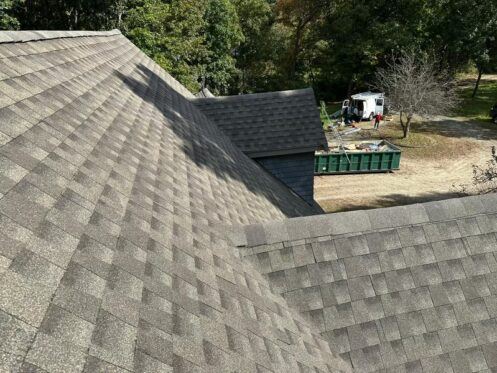If you care about the longevity of your house, you must practice efficient water management. Properly placed downspouts are an important part of this. When professionally installed, downspouts serve a dual purpose: They shield your property from water damage and enhance its curb appeal.
Main Reasons to Install Quality Downspouts
Protecting your property from water damage is the primary function of high-quality downspouts. By properly diverting rainfall away from your house’s foundation, downspouts reduce the likelihood of soil erosion, basement flooding, and structural damage. In addition to preventing water damage, downspouts improve landscape upkeep by keeping water from damaging plants and flowerbeds.
High-quality downspouts also improve the visual attractiveness of a home. Modern downspout designs are available in a wide range of materials and finishes. This gives you the freedom to pick the perfect fit for your house’s architectural style.
Top Causes of Downspout Damage
Clogging is a common problem when dirt, twigs, and leaves build up in the gutters and downspouts. Overflow and harm to nearby places may result if this blocks the water flow. Storms and heavy snowfall are two examples of extreme weather that can lead to downspout damage.
Deterioration, bending, or even dislodging of downspouts from their fasteners may result from hail, falling branches, or other debris that strikes them. Additionally, downspouts manufactured from certain metals are especially vulnerable to corrosion, which may eventually cause structural weakness and leaks.
How to Avoid Downspout Damage
You can prolong the life of your drainage system and protect your downspouts from harm by taking preventive actions. Cleaning the gutters and downspouts on a regular basis is an important part of maintenance to keep them clear. You can also install gutter guards to prevent debris from getting into your gutters while still allowing water to flow freely.
Avoiding physical damage to downspouts requires careful planning. Professionals lessen the likelihood of dents and other structural damage by cutting down any tree branches that might pose hazards during storms and by using materials that are resistant to impact. They can make downspouts last even longer by coating them or using corrosion-resistant materials.
Downspout Installation Process
The size of the property and the intricacy of the drainage system are two elements that determine how long it takes to install downspouts professionally. After the installation, you should have your downspouts checked once a year to make sure they are working properly.
Assessment and Planning
An in-depth evaluation of your property and careful planning of the downspout installation location are the first steps in the process. When deciding where to best install downspouts, roofers take into account the home’s design, landscaping, and water drainage patterns. The purpose of this first stage is to make sure the system can effectively divert precipitation from susceptible regions.
Measuring and Marking
After completing their assessment, roofing experts take precise measurements to ascertain the downspout length and necessary components. To make sure the downspouts properly align with the water drains, they mark their positions on the gutters. This precise marking and measuring procedure is intended to deliver a perfect match between the downspouts and the preexisting structure.
Cutting and Assembly
Cutting the gutter sections at the designated spots and assembling the downspout components are the next steps after placing measurements and marks. Referencing blueprints, the roofers attach elbows and extensions where they’re required. The cutting and installation step is crucial to making sure the downspout system is efficient and fits your property well.
Securing Hangers
Downspout stability and functioning depend on proper support. At regular intervals, the roofers attach gutter hangers along the eaves to support the downspouts. Downspouts rely on these hangers for structural support, which allows them to stay in place and keep water flowing at the correct angle. It is critical to make sure the connection is secure to avoid problems like downspouts drooping or falling off in bad weather.
Attaching to Outlets
The next step in installing downspouts is to attach them to the gutters. To avoid leaks or water seepage, the pros make sure the connection is safe and waterproof. This step is essential for the smooth transfer of rainfall from the gutters to the downspouts.
Ground Installation
Fastening the downspout extensions or diverters to the ground is the last step. This measure makes it possible to avoid soil erosion and possible flooding by diverting rainfall away from the foundation.
Contact Aspen Roofing Services to learn why so many homeowners in Peabody, MA turn to us for downspout installations. We also specialize in residential and commercial roofing services and even provide instant roof replacement quotes.
Give us a call now to learn more about the importance of a professional downspout installation.


